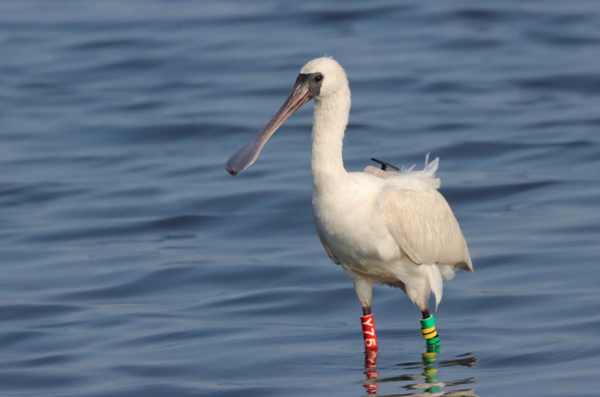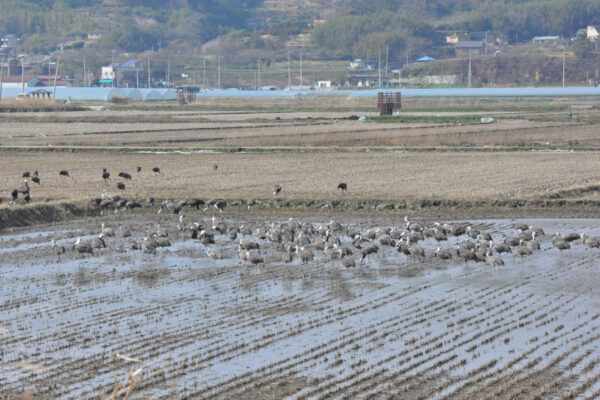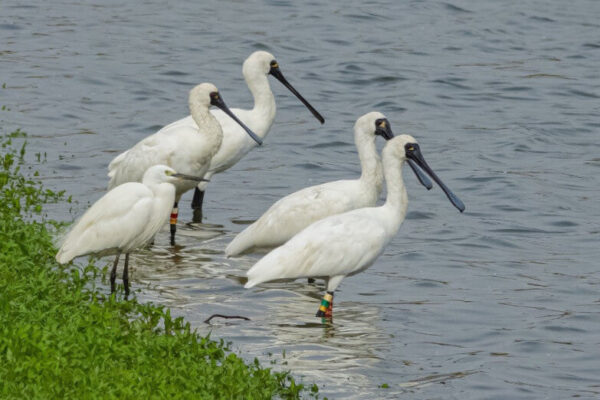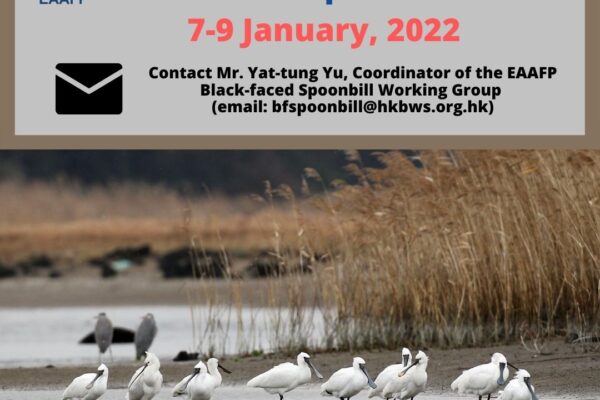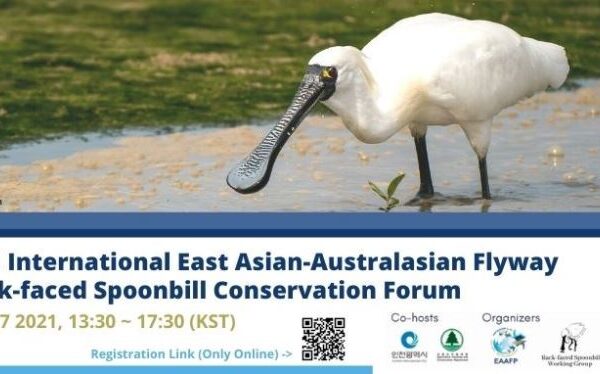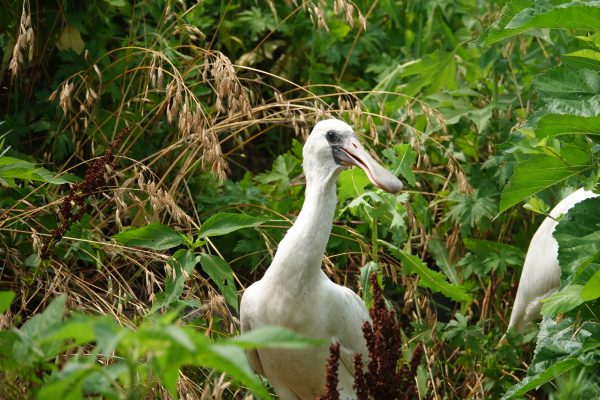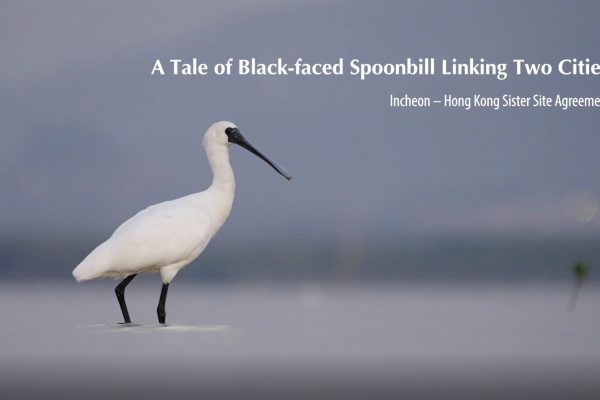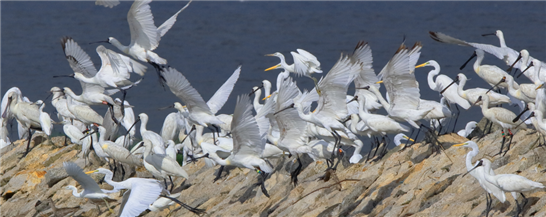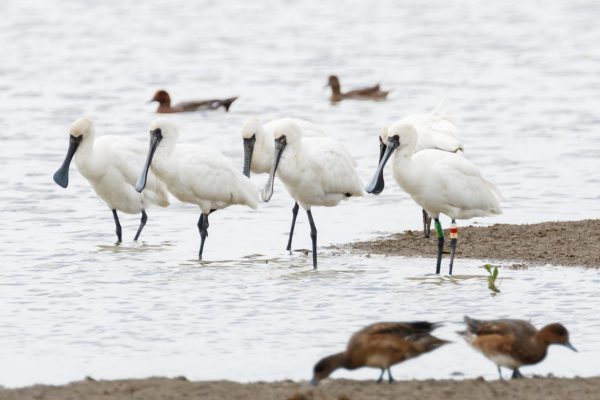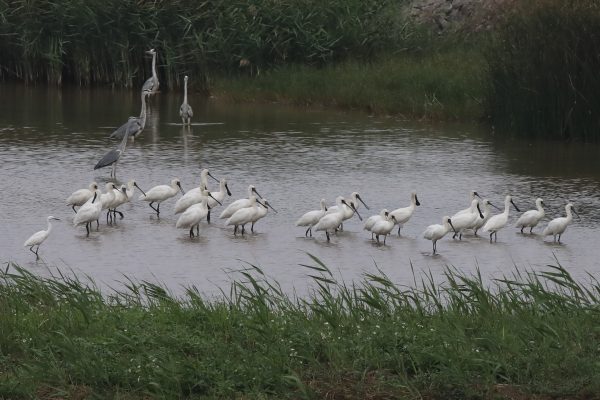-
Juvenile distribution pattern and conservation of the endangered Black-faced Spoonbill
EAAFP Small Grant Fund Project by Chi Yeung Choi, Jimmy Duke Kunshan University The individually-marked Black-faced Spoonbill ‘Y75’, was one of the twenty individuals tagged with satellite tracker. Y75 was ringed on Chilsando, Korea, 2nd July 2020, then seen on Taiwan Island 26th October 2020 ©Yi-Cheng Chen Among the threatened migratory waterbird species in the East Asian–Australasian Flyway (EAAF), the Black-faced Spoonbills (BFS) Platalea minor stands out as one of the very few species showing a recovering trend, from just a few hundred to more than 6,000 over the last 30 years partly due to the extensive conservation effort and BFSs’ ability to utilise artificial wetlands. Over the years, the foraging ecology (Yu et al. 2004a), habitat use (Yu et al. 2004b), threats (Sung et al. 2018) and migration routes (Wood et al. 2013) of BFS have been studied in various locations. Yet relatively little is known about their movement ecology, especially juveniles. In this proposed project, we aim to quantify the wintering distribution pattern of juvenile BFS in their first boreal winter using GPS-GSM transmitters. The ultimate goal is to identify the key regions where juvenile BFS winter and safeguard these areas for the continuous recovery of this endangered population. In 2020 June and July, juvenile BFS were captured near their nests from breeding islands along the west coast of South Korea. Measurements were recorded and unique colour ring combination on the tibia of BFS was used for individual marking. Solar-powered GPS/GSM satellite trackers (19g or 1.3% of juvenile BFS body weight) were deployed to the back of spoonbills using backpack method. Twenty juvenile BFS were captured and equipped with satellite trackers on their back during June and July 2020. Five individuals died without leaving Korea while one individual with tracker failure. In the remaining 14 individuals that left Korea and migrated, 10 of them (71.4%) spent their first winter in mainland China, two (14.3%) on Taiwan Island and two (14.3%) in southeast Japan. Among the 10 individuals that spent their first winter in mainland China, three individuals (30%) stayed in Jiangsu province and another three individuals (30%) in Zhejiang province, while two individuals (20%) resided in Guangdong, one individual in Hainan and one in Anhui. About half of these 14 wintering sites were protected. Among the 14 individuals that left Korea, the one that spent its first winter at the highest latitude (Jiangsu Lianyungang) and the one at the lowest latitude (Hainan) eventually died during their first winter. Our results showed the importance of the coastal wetlands in mainland China, especially those along the Jiangsu, Shanghai and Zhejiang coasts, for juvenile BFS during their southward migration and first winter. All tracked individuals that flew across the Yellow Sea from the west coast of Korea made their first landfall in coastal wetlands along the Jiangsu, Shanghai and Zhejiang coasts. The tracking results indicated the importance of coastal wetlands in Zhejiang Zhoushan, Hangzhou Bay and Wenzhou Bay to juvenile BFS. Moreover, two of the tracked birds that migrated successfully to mainland China for their first winter, eventually died at Lianyungang and Hainan. The cause of mortality was unclear but 35% of tracked BFS died within 6 months after released, showing the challenges that young BFS faced in their early years. It is important to record the potential cause of mortality and mitigate those threats to ensure the continuous population recovery of this endangered species. This project laid the important foundation for further tracking projects that will help researchers to determine the potential drivers for the observed juvenile wintering distribution pattern. This could be achieved by combining the tracking data with findings with annual synchronized censuses. Moreover, the tracking data could also be used to evaluate the extent to which protected areas along the flyway encompass the full range of habitats used by BFS during non-breeding season. The southward migration pathway and wintering distribution of satellite-tracked Black-faced Spoonbills in 2020 References: Sung Y-H, Tse IW-L, & Yu Y-T. 2018. Population trends of the Black-faced Spoonbill Platalea minor: analysis of data from international synchronised censuses. Bird Conservation International, 28(1), 157-167. Wood, C., Tomida, H., Jin-Han, K., Lee, K.S., Cho, H.J., Nishida, S., Ibrahim, J., Hur, W.H., Kim, Yu YT, & Swennen C. 2004a. Feeding of wintering Black-faced Spoonbills in Hong Kong: When and how long? Waterbirds, 27(2), 135-140. Yu YT, & Swennen C. 2004b. Habitat use of the Black-faced Spoonbill. Waterbirds, 27(2), 129-134. The project was funded through the 2020 EAAFP WG/TF Small Grant Fund. View the report, Click here.
Continue reading -
Updates of HPAI recorded in East Asian – Australasian Flyway
Since November 2021, a series of unprecedent outbreaks of HPAI (Highly Pathogenic Avian Influenza) occurred in western Eurasia and depleted significant percentages of waterbirds and seabird populations: Barnacle Goose in Scotland, Eurasian Crane in Israel, Dalmatian Pelican in southeastern Balkans and seabirds along the coast of the Atlantic Ocean. However, no significant incidents were reported from the East Asian-Australasian Flyway except die-offs of several hundred seabirds, such as Tufted Puffins and Rhinoceros Auklets, recorded around the waters of Kunashir Islands in southern Kuril in August 2022, which no official evidence of an HPAI outbreak was indicated by the time of writing. Yet, outbreaks of HPAI was recorded in cranes and other migratory waterbirds in the EAA Flyway in recent two months. Hooded Cranes in Suncheon Bay © Suncheon City On 1 November 2022, a Hooded Crane was found dead at Izumi, Japan and about one week later it was confirmed to be HPAI positive. Numbers of dead birds escalated since, reaching a daily peak of 74 dead Hooded Cranes collected on 17 November. Dead White-naped Cranes were recorded starting on 14 November. The number of daily totals of dead cranes decreased to less than 15 carcasses found from 8 December. As of 23 December 2022, the total number of carcasses of Hooded Cranes collected at Izumi were at least 1,097 and White-naped Crane at least 47. Three Hooded Crane carcasses testing positive of HPAI were collected from Kyushu: 2 from Isahaya and 1 from Akune (Information from the website of Ministry of the Environment Japan, link). Movements of cranes departing from Izumi, Japan were observed from late November. At the same time, there was a surge in the number of Hooded Cranes wintering at Suncheon, Ro Korea. It was speculated some cranes moved from Izumi to wintering sites in Ro Korea. This was proven by Hooded Cranes tracked by Dr Li Xianda in China (from Izumi, Japan to Chonsu Bay, Ro Korea in late November 2022). However, such movement is not irregular as Dr Li’s tagged Hooded Cranes were also recorded travelling between wintering sites in Japan and Ro Korea in 2020 and 2021 (Per. comm. from Li Xianda to Simba Chan). The number of Hooded Cranes at Suncheon reached a peak of several thousand birds in late November but started to decrease to about 3,500 birds in early December. It is believed cranes moved to Chonsu Bay and Galsa Bay, other wintering sites of Hooded Cranes in Ro Korea. The first dead Hooded Crane was found at Suncheon on 13 November. As of 12 December, 158 dead Hooded Cranes and one dead White-naped Crane were found in Ro Korea. On 20 November one sick Red-crowned Crane was captured in Kushiro, Japan and it was tested HPAI positive one week later. However, this should be seen as an independent case of HPAI from the wintering grounds in western Japan. In response to the HPAI outbreak, the Crane Working Group of the EAAFP held an emergency zoom meeting on 12 December and a proposal for reactions to the HPAI in the EAAF region was submitted to the EAAFP Secretariat. The Crane Working Group also sent warnings to other crane wintering sites. So far no abnormal crane deaths has been reported from China and the wintering sites were advised not to artificially feed cranes to avoid concentrations of cranes and other wintering birds. The Crane Working Group has also contacted crane researchers in Israel on possible links between the present incident and the HPAI outbreak at Hula Valley in December 2021, in which about 8,000 Eurasian Cranes died. Advice from Israeli colleagues was to remove crane carcasses especially those in water as quickly as possible and also avoid artificial feeding that would result in concentration of birds. In late November to early December, 34 dead Oriental Storks were found near Tianjin, at the coast of Bohai, China. Poisoning from poachers and HPAI have been ruled out and the cause of death is still under investigation. On 24 November and 12 December, dead Black-faced Spoonbills were found at Mai Po Nature Reserve and Hong Kong Wetland Park in Hong Kong S.A.R. respectively, were confirmed to be HPAI positive. On 9 December another dead Black-faced Spoonbill collected at Kumamoto Prefecture, Japan was also found to be HPAI positive. It is speculated more birds may have died during migration but were not found or reported. At the time when this news release was written, catastrophic HPAI outbreaks are occurring in Latin America, particularly along the coast of Peru where more than 20,000 dead seabirds (majority Peruvian Pelicans) recorded. The massive outbreaks of HPAI that started in western Eurasia in late 2021 are now being recorded in the East Asian Australasian Flyway. The Crane Working Group contacted other species working groups and task forces and almost all agreed on actions that should be taken as soon as possible. While we proposed strategies to be discussed at meetings in 2023, we also urge managers and local stakeholders at important waterbird/seabird sites to take precautions as suggested below, and countries along the flyway should keep in close communication on new cases of outbreaks. Recommendation to important waterbird/seabird sites: Have at least one staff member in charge of biosecurity. Have a contingency plan following the guidance of national authorities in case of outbreak of avian influenza and other avian diseases. Ideally the plan will be rehearsed every year before migratory seasons so staff and volunteers of the site understand all procedures and their roles in case of emergency. Have a contact list of agencies and institutions that can provide support during an outbreak. Have regular monitoring and surveillance on wild birds, particularly when outbreaks are reported along the flyway. In case sick and/or dead birds are found, try to collect them without causing disturbance to other birds. Although the risk of HPAI transmitting to human is low, personal protective equipment has to be used when handling sick or dead birds and the methods of collection and handling should follow national guidelines. Photographing the dead bird for records and to identify the species and gender. Useful references: 2007. Wild Birds and Avian Influenza: an introduction to applied field research and disease sampling techniques. Edited by D. Whitworth, S.H. Newman, T. Mundkur and P. Harris. FAO Animal Production and Health Manual, No. 5. Rome. (download from here) CMS Scientific Task Force on Avian Influenza and Wild Birds Issues Recommendations (2022) (visit the webpage here). Hacen Mohamed El-Hacen. 2022. Workshop report: Development and consequences of the recent bird flu outbreak among Sandwich terns in the Wadden Sea and adjacent areas (download from here) Scientific Task Force on Avian Influenza and Wild Birds statement on: H5N1 Highly Pathogenic Avian Influenza in poultry and wild birds: Winter of 2021/2022 with focus on mass mortality of wild birds in UK and Israel (2022) (download from here) Wildlife Health Australia (2021) The sixth issue Wild Bird News June 2021 - National Avian Influenza Wild Bird Surveillance Newsletter (download from here) More references and useful links are available on webpage of Avian Influenza Working Group (link), News links: Ministry of the Environment, Japan: 高病原性鳥インフルエンザに関する情報 | 自然環境・生物多様性 | 環境省 (env.go.jp) News about dead seabirds washed to Kunashir Islands in southern Kuril (available on 12 August, 2022, visit the webpage here) Article prepared by Crane Working Group.
Continue reading -
Endangered Black-faced Spoonbill breaking the record of over 6000
EAAFP Black-faced Spoonbill Working Group reported another record high of 6,162 for the global population of…
Continue reading -
2022 International Black-faced Spoonbill Census
Black-faced Spoonbill is arriving at their wintering grounds. The EAAFP Black-faced Spoonbill Working…
Continue reading -
2021 Incheon-Hong Kong International East Asian – Australasian Flyway Black-faced Spoonbill Conservation Cooperation Forum
2021 Incheon-Hong Kong International East Asian – Australasian Flyway Black-faced Spoonbill Conservation Cooperation Forum
Continue reading -
Captive-breed Black-faced Spoonbill returned to RO Korea after a year
Written by Dr. Inki Kwon (National Institute of Ecology) Since its artificial breeding in July last year, a Black-faced Spoonbill returned from China to Korea in…
Continue reading -
A Tale of Black-faced Spoonbill Linking Two Cities – Launch of Incheon-Hong Kong Sister Site Agreement video
Sister Site Agreement under the EAAFP Flyway Site Network is a useful mechanism to enhance the collaboration between important sites of migratory waterbirds in the Flyway. In 2019, Governments…
Continue reading -
National Monitoring of Black-faced Spoonbills and study on their habitats in the Republic of Korea, 2020
Study about breeding status, population, national distribution, and habitat use by satellite tracking…
Continue reading -
Record breaking for Black-faced Spoonbills population hits over 5,000 in 2021
The Hong Kong Bird Watching Society (HKBWS), EAAFP Partner, coordinated the International Black-faced Spoonbill Census 2021 (the Census) from 15th to 17th January. The global population of the Endangered…
Continue reading -
2021 International Black-faced Spoonbill Census announcement
The annual International Black-faced Spoonbill Census is scheduled on 15-17 January 2021. This event has been one of the core activities of Black-faced Spoonbill conservation since the commencement in…
Continue reading
- 1
- 2

